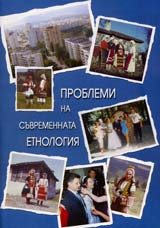
We kindly inform you that, as long as the subject affiliation of our 300.000+ articles is in progress, you might get unsufficient or no results on your third level or second level search. In this case, please broaden your search criteria.






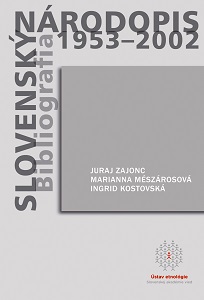
Zavŕšenie polstoročia vo vydavani Slovenskeho narodopisu je udalosťou, ktora ponukla možnosť rekapitulovať uplynule desaťročia nielen v živote tohto vedeckeho periodika, ale jeho prostrednictvom aj skupiny disciplin, formujucich sa na Slovensku od narodopisu, zastrešujuceho etnografiu a folkloristiku, k dnešnej etnologii, kulturnej a socialnej antropologii. Tieto prostrednictvom Slovenskeho narodopisu prezentovali svoje poznatky, komunikovali s vedcami z inych krajin, disciplin i s verejnosťou. Možnosť spoznať širku tem, ktore boli v uplynulych paťdesiatich rokoch predmetom zaujmu tohto vedneho odboru (bez ohľadu na jeho aktualny nazov), prehľad osobnosti, ktore vstupovali prostrednictvom časopisu do vedeckej komunikacie, i kvantitativny pohľad na ich vedecku produkciu na jeho strankach prinaša tato Bibliografia. Rovnako doležitympodnetom jej vzniku bola potreba vytvoriť komplexnu pomocku, umožňujucu vyhľadavať podľa viacerych kriterii v časopise publikovane texty ako pramene udajov a poznatkov pre ďalšie badanie. Bibliografia nadvazuje na pracu Milady Kubovej Register časopisu Slovenský národopis. Ročníky I – XXV (1953–1977), ktoru publikovala ako prilohu prveho čisla Slovenskeho narodopisu v roku 1978. Ide o tematicky usporiadanu bibliografiu prvych 25 ročnikov časopisu s autorskym registrom. Podnet na vytvorenie bibliografie 50 ročnikov Slovenskeho narodopisu vyšiel približne v roku 2002 od Hany Hloškovej, vtedajšej vedeckej pracovničky Ustavu etnologie SAV, redaktorky Slovenskeho narodopisu a sučasne externej pedagogičky na Univerzite Konštantina Filozofa v Nitre.
More...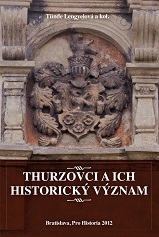
Das vorliegende Sammelband „Die Thurzo und ihre historische Bedeutung“ ist das Ergebnis der Zusammenarbeit von Historikern aus der Slowakei, Ungarn und Deutschland. Die Grundlage für die Entstehung dieser Publikation bereitete die internationale Konferenz, die im Jahre 2009 anlässlich des 400. Jahrestags der Wahl von Georg Thurzo zum ungarischen Palatin veranstaltet wurde. Die anregungsvolle Tagung und Diskussion, sowie die weiteren Untersuchungen zum Thema boten genügend Unterlagen für die Zusammenfassung der Beiträge in einem Sammelband. Das erste Kapitel trägt den Titel Der Weg in die ungarische Aristokratie und hier werden die wichtigsten Vertreter des Geschlechts Thurzo vorgestellt, die sich am meisten um seinen politischen und wirtschaftlichen Aufstieg verdienten. Géza Pálffy analysiert in dem Unterkapitel Die Familie Thurzo und ihre Stellung in der ungarischen Aristokratie die Karrieremöglichkeiten im Königreich Ungarn am Ende des Mittelalters und zu Beginn der Frühen Neuzeit, sowie die Möglichkeiten, die die einzelnen Mitglieder des Geschlechts nutzten, um ihre Ambitionen zu erfüllen. Marián Skladaný widmet sich im Unterkapitel Der wirtschaftliche Aufstieg der Thurzo den ersten Vertretern der Familie, die zuerst zum niederen Adel gehörten und für eine gewisse Zeit zum Bürgertum wechselten, damit sie sich der kaufmännischen und unternehmerischen Tätigkeit widmen und den Wohlstand der Familie begründen konnten. Gabriella Erdélyi stellt in ihrem Beitrag „Ich bin nur ein Mensch, mein König, kein Stein“ – Alexius Thurzo im Dienst der Habsburger einen der einflussreichsten Thurzo-Männer vor, dessen kaufmännisch-unternehmerische Tätigkeit den ganzen mitteleuropäischen Raum umfasste, wobei er auch wichtige Funktionen vertrat und zu den Vertrauensmännern des Herrschers Ferdinand I. und der Königin Maria von Ungarn gehörte. Ein weiteres bedeutendes Familienmitglied präsentiert Lajos Gecsényi im Unterkapitel Der rätselhafte Thurzo. Franz Thurzo, der Präsident der Ungarischen Kammer und der Hofkammer (1549 – 1563). Das zweite Kapitel widmet sich dem Thema Die Thurzo und die Reformation. Mehrere Mitglieder des Geschlechts gehörten zur hohen Kirchenhierarchie und wurden vordergründig durch ihre Kontakte zu Humanisten und ihr großzügiges Mäzenatentum bekannt. Einen der bedeutendsten Bischöfe aus der Familie Thurzo stellt Martin Rothkegel im Unterkapitel Die Beziehungen des Olmützer Bischofs Stanislaus I. Thurzo zu Ungarn vor. Die Reformation fand unter den Mitgliedern des Geschlechts auch zahlreiche Anhänger, über sie schreibt Zoltán Csepregi in seinem Beitrag Die Thurzo und die Anfänge der Reformation. Diejenigen Vertreter der Familie, die ihr Reichtum auf der unternehmerischen Tätigkeit begründeten, dachten auch auf ihre weniger wohlhabenden Mitmenschen und gründeten mehrere Stiftungen zu ihrer Unterstützung. Tünde Katona stellt in diesem Zusammenhang in ihrem Beitrag die Leutschauer Stiftung der Thurzo vor. Das dritte Kapitel wird der Problematik der Höfe der Thurzo als Zentren des wirtschaftlichen, politischen und gesellschaftlichen Lebens gewidmet. Die Thurzo erlebten einen interessanten Übergang von den adeligen in den bürgerlichen Stand und von dem Reichtum, das sich durch ihre unternehmerische Tätigkeit angehäuft hatte, kauften sie Gutsherrschaften, damit sie erneut nicht nur in den Adelsstand zurückkehren, sondern gleich in die Aristokratie aufsteigen konnten. Tünde Lengyelová untersucht Die wirtschaftlichen Verhältnisse an den Gutsherrschaften der Thurzo an der Wende des 16. und 17. Jahrhunderts. Einen wesentlichen Aufgabenbereich des Palatins stellte die Verwaltungsagenda dar, über die Péter Dominkovits in seinem Beitrag Die Kontakte des Palatins Georg Thurzo zu den Komitaten Ödenburg und Eisenburg einen Überblick bietet. Einen Blick in das Alltagsleben an den Höfen gewähren in ihren Beiträgen Diana Duchoňová im Unterkapitel Die Hofordnungen an den Höfen der Thurzo und der Esterházy, sowie Borbála Benda, die sich der Speisekarte von Stanislaus Thurzo aus dem Jahre 1603 widmet. Das vierte Kapitel befasst sich mit den verschiedenen Formen des Kulturnachlasses der Thurzo. Zuzana Ludiková und Árpád Mikó präsentieren die Bestattungsstätten und Grabdenkmäler der Thurzo nicht nur als Symbole ihrer Macht, sondern auch als künstlerische Ausdrucksformen. Eine bedeutende Quelle zur genealogischen Untersuchungen stellen die Hochzeitseinladungen der Thurzo dar, die Frederik Federmayer näher beschreibt. In dem umfangreichen heimatkundlichen Werk von Matthias Bel wären die genealogischen Forschungen des Polyhistors fast untergegangen, deshalb richtet Gergely Tóth den Blick gerade auf diesen Aspekt in seinem Beitrag „Theatrum Nobilitatis Hungaricae“. Die genealogischen Untersuchungen von Matthias Bel mit besonderem Augenmerk auf die Familie Thurzo. Zu den wichtigsten Mäzentätigkeiten der Thurzo gehörten die Förderung der Studenten an ausländischen Universitäten, sowie die Veröffentlichung von verschiedenen Publikationen und die Unterstützung von Druckereien. Über derartige Aktivitäten des Palatins und seiner Familienmitglieder schreibt Helena Saktorová in ihrem Beitrag Die Persönlichkeit von Georg Thurzo im Spektrum seiner Autorendedikationen. Mit dem schriftlichen Nachlass der Familie Thurzo im Staatsarchiv von Bytča befasst sich Jana Kurucárová. Die Ergebnisse einer außergewöhnlichen und seltenen Untersuchung präsentieren die Anthropologen Milan Thurzo und Radoslav Beňuš in ihrem Beitrag Die anthropologische und paläopathologische Analyse der Gebeine der Familienmitglieder von Georg Thurzo. Damit gewähren sie einen einzigartigen Einblick in den gesundheitlichen Zustand von mehreren Vertretern dieses Geschlechts. Arwa, heute Orava war die grösste Gutsherrschaft der Thurzo und die hießige Burg gehörte zu den bedeutendsten Zentren der Familie, aus diesem Grund widmeten sie eine besondere Aufmerksamkeit ihrer architektonischen Gestaltung, die Michal Čajka in seinem Beitrag Die Umbauten der Burg von Orava in der Zeit der Thurzo schildert. Die Publikation enthält eine Reihe von neuen Kenntnissen, die das Ergebnis von intensiven Untersuchungen mehrerer Historiker, Kirchenhistoriker, Archäologen, Anthropologen, Archivaren und Kunsthistoriker darstellen. Trotzdem gibt es noch genügend Themen und Fragen, die auf Aufarbeitung warten und weitere Anregungen für Forschungen über diese interessante Familie darbieten, deren Mitglieder nicht nur zur übernationalen Aristokratie des Königreichs Ungarn und der mitteleuropäischen Habsburgermonarchie, sondern auch zu den außerordentlich begabten Unternehmern, Politikern, Soldaten und bedeutenden Vertretern des kulturellen Lebens an der Schwelle des Mittelalters zur Frühen Neuzeit gehörten.
More...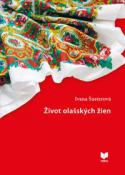
One can write about the Roma people in many ways. The intention of writing about them can also be different. I made my way “into the field” with an open mind and heart in order to explore one of the groups of Roma. By doing so, I aimed to discover as many objective facts as possible. The objective was to discover, to such an extent, these facts in which the Wallachian Roma shared and supported directly with their testimonies. The book is an ethnographic description of selected aspects of life of a particular Roma group – Wallachian Roma (Lovara) living in Nitra. This group forms a small percentage of the Roma population in Slovakia and is mainly presented as a closed community which is hard to penetrate. This seems to be one of the reasons why there is an absence of information about Wallachian Roma; not only to the general public, but also among experts – in spite of the fact that Wallachian Roma form a special sub-ethnic group which is characterised, among other things, by the preservation of traditional norms, specific forms of behavior, and a set of unique habits in their community that persists even today. An important feature which influences the way of life of Wallachian Roma isa persistent solidarity among them by observing family and community rules. The book aims to describe and analyse the position of women within the community of Wallachian Roma today, present the picture of a Wallachian woman living her everyday life subordinated to the internal rules and laws of the community and focuses on the transformation of her position throughout her life. The publication focuses particularly on the current situation, but also observes the preservation of the traditional model of women´s position within the community of Wallachian Roma, the possible generation differences and the penetration of newer forms. The book also deals with factors influencing their formation, and aims to grasp this issue in the most comprehensive manner possible from the point of view of several generations and both sexes. The data presented in the book represent the results of field research conducted on Borová Street in Nitra, where the Wallachian community is concentrated within a compact residential unit. The current population of this community is around 350–400 adult Roma with children from the Ferkošť family who have lived at this location since 1958 when the first house was built there. The content of the book places emphasis on the changes in the position of women from their birth up to old age.
More...
The book refers to the kitchen as a living space (private, domestic, semi-public) that has many cultural and social connotations, presented on some chosen examples. The authors of particular texts discuss both modern ways of using the kitchen space, the ways it is arranged and equipped, a specification of kitchen designs from the perspective of established cultural and social patterns, the ways meals are arranged in mass catering institutions and aid institutions, as well as functioning of kitchen space in traditional rural culture, in urban working-class environment, in Middle Ages and in antiquity. The publication is addressed to cultural studies and social life researchers, interested in the kitchen space and related practices, not only the culinary ones. The texts contained in this work may also act as a source of knowledge and inspiration for people dealing with analysis of residential strategies, set in various historical contexts, and designing the space and the whole range of items used for kitchen purposes. // Książka dotyczy kuchni jako przestrzeni życiowej – prywatnej, domowej, półpublicznej – kojarzonej z wieloma kulturowymi i społecznymi znaczeniami ukazanymi na wybranych przykładach. Autorzy tekstów omawiają zarówno współczesne sposoby korzystania z pomieszczeń kuchennych, ich aranżacje i wyposażenie, specyfikę projektów kuchni z perspektywy wypracowanych wzorów kulturowo-społecznych, sposoby organizacji posiłków w placówkach zbiorowego żywienia i instytucjach pomocowych, jak i funkcjonowanie przestrzeni kuchennych w tradycyjnej kulturze chłopskiej, robotniczym środowisku miasta oraz w okresie średniowiecza i starożytności. Publikacja jest kierowana do badaczy kultury i życia społecznego, zainteresowanych przestrzenią kuchni i związanymi z nią praktykami, nie tylko kulinarnymi. Może stanowić także źródło wiedzy i inspiracji dla osób zajmujących się analizą strategii zamieszkiwania, osadzonych w różnych kontekstach historycznych oraz projektowaniem przestrzeni i całej palety przedmiotów użytkowanych na potrzeby kuchenne.
More...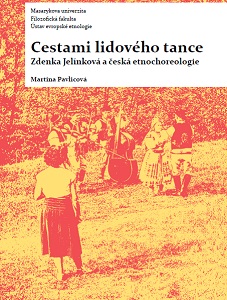
Zdenka Jelínková was a prominent researcher in the area of folk dancing, who was present at the birth of Czech ethnochoreology after the Second World War. She was born on 30th March 1920 in south-eastern Moravia in Velká nad Veličkou, which belongs to the Horňácko ethnographic region. In her childhood and youth she still had opportunities to encounter numerous manifestations of traditional folk culture, which were gradually disappearing from everyday life due to the influence of modern society. She came from a white-collar family; however, she was attracted by rural folk culture, mainly folklore manifestations. She regularly returned to Horňácko even after her family moved to Brno. The closure of universities during the Nazi occupation in 1939 prevented her from studying the subjects she had already enrolled in (Physical Education – French), therefore she at least graduated from the school for instructors of the Czech Sokol Community (Česká obec sokolská) in Prague (1940) and worked as a teacher at various schools until 1950. Her interest in folk dancing and in children folklore did not wane even during her teaching career; she was also active in the folklore movement. In 1949 her erudition brought her to a group of collectors who were making folklore records for the collections of the Folk Song Institute (Ústav pro lidovou píseň) in Brno. In 1950 she was hired as a qualified worker of this institution and worked here until her retirement in 1982. Not even then did she give up her ethnochoreological activities. She died on 5th October 2005.
More...
Předložená monografie se věnuje problematice českého pohádkového příběhu v rozpětí od roku 1990 do roku 2010. Instalace svobodného knižního trhu, proměny ediční politiky se vstupem nových nakladatelských domů na českou literární scénu, konfrontace se zahraničními vlivy a především odlišné čtenářské kompetence současných dětí ovlivnily pochopitelně i žánrovou mapu současné literatury pro děti a mládež. Od 90. let 20. století se začínají rozvolňovat tradičně vnímané hranice, jimiž se literatura určená dětem vydělovala jako subsystém navenek, ale i hranice, které ji vnitřně žánrově i hodnotově stratifikovaly a čtenářsky kategorizovaly.
More...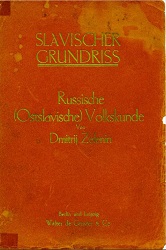
This is the digitized copy of the book published in 1927 as one volume of the "Grundriss der slavischen Philologie und Kulturgeschichte", edited by Reinhold Trautmann and Max Vasmer in the publishing house "Walter de Gruyter & Co". For Detailed information regarding the content, please download the Table of Content from the "Contents"-Tab here below.
More...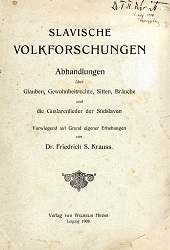
published in 1908 by Wilhelm Heims Publisher in Leipzig.
More...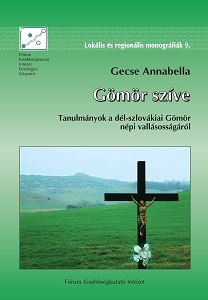
This work is a publication of the results of a research that was undertaken with the support of the János Bolyai Research Scholarship of the Hungarian Academy of Sciences in the period between 2011 and 2014. During my research, I examined the 20th century folk religiosity of nine Hungarian villages in southern Slovakia: Abafalva (Abovce), Baraca (Barca), Cakó (Cakov), Füge (Figa), Méhi (Včelince), Rimaszécs (Rimavská Seč), Sajószentkirály (Kráľ), Uzapanyit (Uzovská Panica), and Velkenye (Vlkyňa). The area is one of the Catholic regions of the ethnically, linguistically and religiously mixed Gemer, mostly in a Protestant environment.In the introductory chapter of my work, I interpret the concept of folk religiosity and religious ethnography with an overview of academic literature, and then—also with previous research results—I outline the important features of the research area. I divided the folk religiosity of the nine villages into two large units by village. I presented a picture of the folk religiosity of the first half of the 20th century on the basis of records deposited with the Episcopal Archives in Rožňava. As far as possible, I analyzed the data, which developed mostly from Hungarian, and to a lesser extent Slovak, documents on the basis of the same aspects, I tried to capture the relationship and dialogue of the “official” church, the perception of religious practitioners and parishioners and cantors of each other. Specific data for this interpretation were provided by the conflict situations: the two world wars, the expulsions and resettlements, the population exchange, and finally the constraint of the churches after the Second World War. The researchability of ecclesiastical archival sources ends in the early 1950s, so I have expanded the interpretation of the concept of “religiosity of today” from this period to the present day. I obtained data on the folk religiosity of the other time unit by village through field research, ethnographic collecting and participant observation. In the process, I was able to capture the image of the examined villages about each other, and also the characteristics that serve as the basis of the opinions. By analyzing these, the interpretation of the data obtained by the two methods ends. Subsequently, I compiled the archival sources in a separate chapter entitled Data Archive, particularly due to the relatively difficult access to the Episcopal Archives in Rožňava. Here, too, I arranged the documents by village, sometimes only describing their content, but most of the time I published the texts literally, in their entirety, from the analysis of which chapters dealing with the first half of the 20th century were composed. During the field research, I prepared a survey of small sacral relics in all villages. The photographic, measured drawing and text presentation of these forms the next chapter of my work, I have edited the descriptions, drawings and photographs of slightly more than fifty roadside crosses and sculptures into a data repository based on uniform aspects. Finally, for two full years, 2011 and 2012, I compiled the annual order of the spiritual folk songs performed at the Sunday and festive masses in Baraca. In the second year, I also filmed about 50 hours of mass. These recordings are available in the book using QR codes.In the course of my work, the strongest characteristics of the folk religiosity of the examined villages had unfolded. Archival sources provided data on what is the basis of the image of a village in the others. As much as I got a colourful picture of the first half of the 20th century, it is so much common the most defining feature of the religiosity of today. In all villages it could be proved that the official ecclesiastical persons have a much smaller influence on the practice of religion than the so-called laymen, who in all cases are local members of the community (unlike parishioners), native Hungarian speakers (often unlike parishioners) and key persons in religious life. These key people are often amateur cantors, ecclesiastical omnivores in one person, who still keep up the repertoire of folk songs, eulogies, the order of ceremonies, and forms of religious conduct of the 1940s.
More...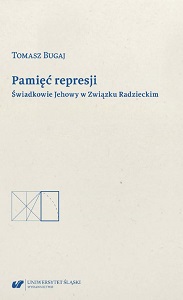
[an excerpt from a review] “The monograph showing the narrative aspects of Jehovah's Witnesses' memory significantly complements memory studies by showing how culture and religion influence images of traumatic events from the past. Analysing the narrations of the respondents, the author draws attention to the mechanisms of evaluation (e.g. of torturers) and taming the trauma of the past, and these mechanisms result – as the reading of the book shows – from the religion and the values transmitted in it.The monograph is therefore an interesting, valuable and necessary study. It is an erudite work, the author refers not only to the works of culture scholars, but also sociologists, including the sociologists of religion, which I think is justified and necessary. It is based on a large, representative, and what should be appreciated, independently collected material, which includes narratives of members of the examined community living previously in the borderlands, as well as those living on the territories of several former republics of the USSR”.
More...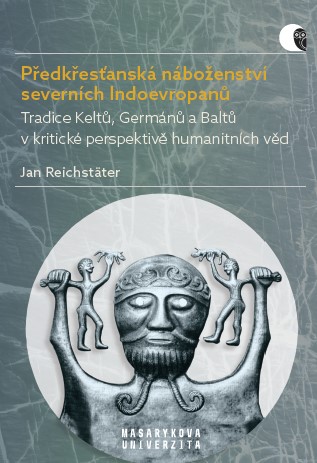
The book aims to offer insights into research on the pre-Christian religions of the northern Indo-Europeans – namely the traditions of the Celtic, Germanic, and Baltic peoples. It presents the results of current research in the spheres of the pantheons, rituals and mythologies of these ethnic groups gained by those branches of the humanities that are usually involved in scientific reconstruction of archaic religions (e.g. archaeology, philology, ethnology). Significant attention is paid to the interpretational problems that have been solved by specialists in the study of these extinct religions for a long time. The book also introduces a brief history of the research in these fields, whose beginnings are mostly connected with the Romantic era, but in some regions they can be traced back as far as the period of Renaissance humanism. In this context the ideological motivations and aims which shaped – or still shape – the images of these religions, both in science and popular culture, are emphasised.
More...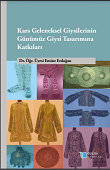
From its creation until the present day, humans have often not lived within their own borders and have constantly moved. During this change of location, they both carried their culture to where they went and adopted the culture of the places they settled. This situation either destroyed or complicated many traditions. Information on clothing, which is an important part of Kars culture, is included in historical documents piece by piece and independently from each other. It is seen that there is no holistic and comprehensive research on Kars clothing, which is important in terms of ethnic, national and sociocultural aspects. In addition, it is considered a necessity to make artistic publications on the elements of Kars clothing. In the book, the clothing characteristics of the people of Kars, as men and women, are examined; upper body wear, lower body wear and garment are detailed as complements. Afterwards, the clothes were examined and 12 women's capsule collections of size 38 were prepared. This collection is in a daily wearable style and consists of 30 pieces. Technical leaflets of the capsule collection prepared in the study were prepared and produced in the Coral Draw program. The clothes produced were dressed and photographed on the lifeless mannequin and arranged by cleaning the back in Photoshop. With this study, Kars clothes, which were about to disappear, were tried to be brought to light, and modern style women's clothes were produced based on these clothes. Thus, Kars traditional clothing, which is one of our cultural heritages and considered as cultural carrier, has been modernized technically and artistically, and has been made usable for present and future generations.
More...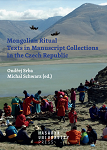
The present book is a critical edition of Mongolian ritual manuscripts preserved in Czech collections. It offers palaeographic descriptions and transcriptions for all the manuscripts, accompanied by English translations and selected facsimiles. The edition includes the majority of popular ritual text categories written in Classical Mongolian (mostly incense offering rituals) commonly circulating in the extramonastic milieu of premodern Mongolia: texts on fire-worship, White Old Man, Offering of the Fox, Geser Khan rituals, hunting rituals, while several texts related to cults of local deities, protection of livestock, as well as popular religious songs and individual prayers are appearing in the scholarly literature for the first time.
More...
The book touches upon issues largely absent from the usual nation-centred historiography. The authors describe life in the Polish-Ukrainian borderland, laying bare the mechanisms that led to the collapse of pre-war social order and scrutinizing the survival strategies used by the local population, one of which was the labile recourse to ethnic identity depending on the situation at hand. The book offers a multifaceted insight into the dynamic of social relations in the period’s countryside, including the situation of women and the attitudes towards the civilian population on the part of partisans from different formations. Much attention is devoted to child witnesses of violence and the specificity of the memory stemming from those experiences. Also discussed is the perception that today’s inhabitants of the region have of their local identity as well as the role played in the processes of remembering and recalling the past by the material surroundings.
More...